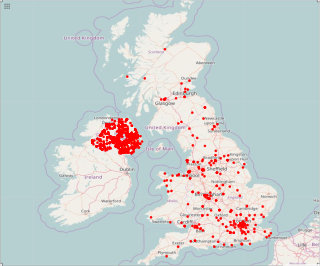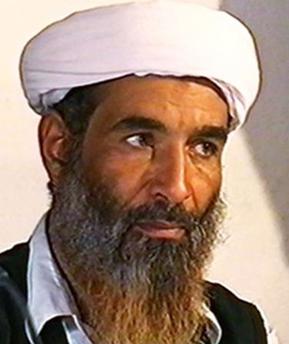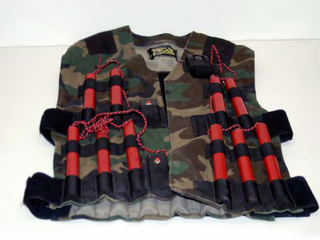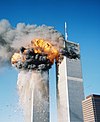
Al-Qaeda is a pan-Islamist militant organization led by Sunni Jihadists who self-identify as a vanguard spearheading a global Islamist revolution to unite the Muslim world under a supra-national Islamic state known as the Caliphate. Its membership is mostly composed of Arabs, but also includes people from other ethnic groups. Al-Qaeda has mounted attacks on civilian, economic and military targets of the US and its allies; such as the 1998 US embassy bombings, the USS Cole bombing and the September 11 attacks. The organization is designated as a terrorist group by NATO, UN Security Council, the European Union, and various countries around the world.
State-sponsored terrorism is terrorist violence carried out with the active support of national governments provided to violent non-state actors. States can sponsor terrorist groups in several ways, including but not limited to funding terrorist organizations, providing training, supplying weapons, providing other logistical and intelligence assistance, and hosting groups within their borders. Because of the pejorative nature of the word, the identification of particular examples are often subject to political dispute and different definitions of terrorism.
Earnest James Ujaama is an American community activist and former terrorist.
Terrorism financing is the provision of funds or providing financial support to individual terrorists or non-state actors.
Oussama Abdallah Kassir is a Lebanese-born militant Islamist. He is a citizen of Sweden who served a prison sentence in Sweden on a number of violence and drug related offenses, and was later convicted by an American court for conspiring to support terrorism.

Jamaat al-Dawah ila al-Quran wal-Sunnah, abbreviated as JDQS, also known as The Salafi Group, was a militant Islamist organisation operating in eastern Afghanistan.

The war on terror, officially the Global War on Terrorism (GWOT), is a global military campaign initiated by the United States following the September 11 attacks and is the most recent global conflict spanning multiple wars. The main targets of the campaign are militant Islamist movements like Al-Qaeda, Taliban and their allies. Other major targets included the Ba'athist regime in Iraq, which was deposed in an invasion in 2003, and various militant factions that fought during the ensuing insurgency. After its territorial expansion in 2014, the Islamic State militia has also emerged as a key adversary of the United States.

Terrorism in the United Kingdom, according to the Home Office, poses a significant threat to the state. There have been various causes of terrorism in the UK. Before the 2000s, most attacks were linked to the Northern Ireland conflict. In the late 20th century there were also attacks by Islamic terrorist groups. Since 1970, there have been at least 3,395 terrorist-related deaths in the UK, the highest in western Europe. The vast majority of the deaths were linked to the Northern Ireland conflict and happened in Northern Ireland. In mainland Great Britain, there were 430 terrorist-related deaths between 1971 and 2001. Of these, 125 deaths were linked to the Northern Ireland conflict, and 305 deaths were linked to other causes, including 270 in the Lockerbie bombing. Since 2001, there have been almost 100 terrorist-related deaths in Great Britain.
In United States law, providing material support for terrorism is a crime prohibited by the USA PATRIOT Act and codified in title 18 of the United States Code, sections 2339A and 2339B. It applies primarily to groups designated as terrorists by the State Department. The four types of support described are "training," "expert advice or assistance," "service," and "personnel."

Mohammed Atef was the prominent military chief of al-Qaeda, and a deputy of Osama bin Laden, although Atef's role in the organization was not well known by intelligence agencies for years. He was killed in a US airstrike in November 2001.

Foreign fighters have fought on all four sides of the Syrian Civil War, as well both sides of the War in Iraq. In addition to Sunni foreign fighters, Shia fighters from several countries have joined pro-government militias in Syria, leftist militants have joined Kurdish forces, and other foreign fighters have joined jihadist organizations and private military contractors recruit globally. Estimates of the total number of foreign Sunnis who have fought for the Syrian rebels over the course of the conflict range from 5,000 to over 10,000, while foreign Shia fighters numbered around 10,000 or less in 2013 rising to between 15,000 and 25,000 in 2017.

The Military of the Islamic State is the fighting force of the Islamic State (IS). The total force size at its peak was estimated from tens of thousands to over two hundred thousand. IS's armed forces grew quickly during its territorial expansion in 2014. The IS military, including groups incorporated into it in 2014, openly operates and controls territory in multiple cities in Libya and Nigeria. In October 2016, it conquered the city of Qandala in Puntland, Somalia. It conquered much of eastern Syria and western Iraq in 2014, territory it lost finally only in 2019. It also has had border clashes with and made incursions into Lebanon, Iran, and Jordan. IS-linked groups operate in Algeria, Pakistan, the Philippines, and in West Africa. In January 2015, IS was also confirmed to have a military presence in Afghanistan and in Yemen.
Tariq bin al-Tahar bin al-Falih al-'Awni al-Harzi, also known as Abu Umar al-Tunisi, was a Tunisian man and senior leader of the Islamic State.

Samir Hijazi, known as Abu Humam al-Shami or Faruq al-Suri, is a Syrian militant and soldier who was the military chief of al-Qaeda's Syrian affiliate al-Nusra Front. He became the head of the Guardians of Religion Organization in February 2018, though he was replaced by Khalid al-Aruri.

The Islamic State – Khorasan Province is a regional branch of the Salafi jihadist group Islamic State (IS) active in South-Central Asia, primarily Afghanistan and Pakistan. ISIS–K seeks to destabilize and replace current governments within historic Khorasan region with the goal of establishing a caliphate across South and Central Asia, governed under a strict interpretation of Islamic sharia law, which they plan to expand beyond the region.

The Islamic State – Somalia Province or Abnaa ul-Calipha is an Islamic State–affiliated group that primarily operates in the mountainous areas of Puntland, and which has also claimed responsibility for several terrorist attacks throughout the rest of Somalia. Led by Sheikh Abdul Qadir Mumin, the group is estimated to have up to 300 active fighters. Since its formation, ISS probably managed to take control of a small, sparsely populated territory in northern Somalia's mountainous hinterland, though it was not acknowledged as official province ("Wilayat") by IS's central leadership until December 2017. Since then, it has sometimes been called Somalia Province by pro-IS media. ISS is also the declared enemy of al-Shabaab, which considers the Islamic State a significant threat to its own predominance among Jihadist factions in Somalia.
The Philippines is one of the state opponents of the militant group, Islamic State of Iraq and the Levant (ISIL), more commonly referred to by the local media as the Islamic State of Iraq and Syria (ISIS).

Inghimasi, also called shahid and istishhadi, are forlorn hope or suicide attack shock troops utilized by several Sunni jihadist groups, such as the Islamic State of Iraq and the Levant (ISIL), al-Qaeda, Jabhat al-Nusra, Tahrir al-Sham, Boko Haram, and al-Shabaab.

Foreign fighters in the Syrian civil war have come to Syria and joined all four sides in the war. In addition to Sunni foreign fighters arriving to defend the Islamic State of Iraq and the Levant or join the Syrian rebels, Shia fighters from several countries have joined pro-government militias in Syria, and leftists have become foreign fighters in the Syrian Democratic Forces.










